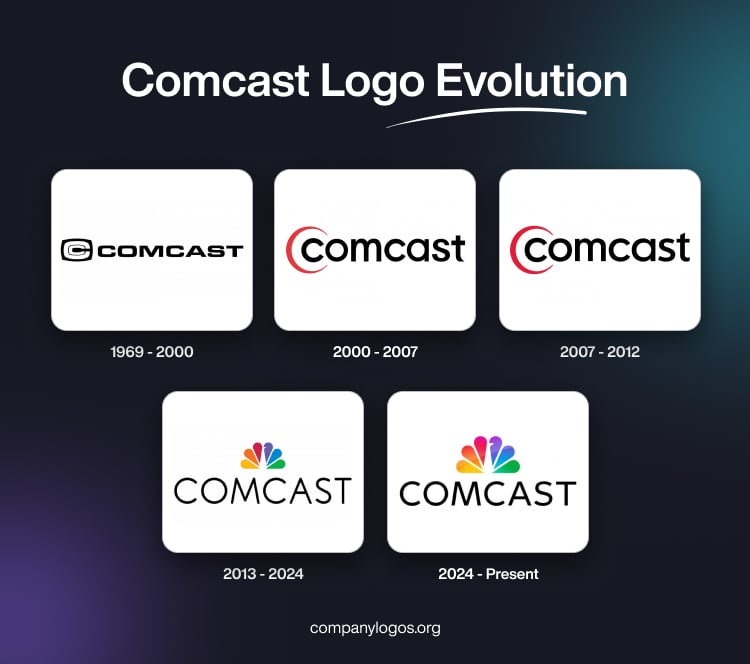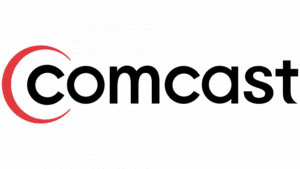
Comcast is a large US-based media and telecommunications company operating under the Xfinity brand. The company offers a range of services, which includes high-speed internet, mobile, landline, and cable television. It is also the owner of a string of movie studios, like NBCUniversal, besides television networks, and theme parks. It is also involved in creating content as well as distributing and delivering it across various channels.
The Comcast logo has undergone a few changes since the founding of the company. Each of these changes reflects the growth, evolving identity, and expanding media presence of the company. The article delves into the evolution of the Comcast logo, among other details of the company.
The Genesis of the Comcast Logo (1963 – 1969) (Unavailable)
The initial name of Comcast was American Cable Systems, which was established on June 28, 1963. However, there is no documented information about the logo of the company.
(1969 – 2000)
It was only in 1969 that American Cable Systems was re-incorporated as Comcast Corporation. Thereafter, the company introduced its first official logo. This design featured a strong, uppercase wordmark “COMCAST” in black, using a bold sans-serif typeface similar to Microgramma Std Bold Extended. To the left of the wordmark, the logo displayed an emblem. It was a stylised image of two interlocking “C”s within a solid black square. The design conveyed professionalism, stability, and strength and remained unchanged for over 30 years.

(2000 – 2007)
In 2000, Comcast modernised its visual identity to reflect its growing role in digital cable and internet services. The new logo featured the brand name in lowercase letters using a modified Futura typeface, which gave it a more approachable and contemporary look.
The emblem to the left was simplified to a red, stylised “C” that encircled the first letter of the wordmark. The use of red and black symbolised energy, power, and professionalism. Besides, it aligned with Comcast’s ambitions as a major media provider.

(2007 – 2012)
The 2007 update brought only minor changes. The wordmark became bolder and more geometric and was written using a sans-serif font similar to URW Geometric Arabe SemiBold. The red “C” emblem and the colour palette remained unchanged, which reinforced the already established brand identity of Comcast.

(2013 – 2024)
After acquiring a majority stake in NBCUniversal, the Comcast logo underwent a major transformation. The NBC peacock, with its six colourful, rainbow-coloured feathers, was placed above the Comcast wordmark. The word “COMCAST” appeared in a thin, elegant, all-caps sans-serif font, likely from the Intervogue family. The peacock emblem signified Comcast’s expanded reach into television, entertainment, and content production, while the modern wordmark projected expertise and style.

(2024 – Present)
The latest logo update further emphasises Comcast’s connection to NBCUniversal. The colourful NBC peacock sits prominently above a modern, sans-serif “COMCAST” wordmark. The text is clean, bold, and black and contrasts sharply with the vibrant peacock emblem above to ensure clarity and brand recognition.
This logo encapsulates Comcast’s dual identity, that is, tradition and heritage through the iconic NBC peacock. It also displays innovation through minimalist, contemporary typography. The rainbow colours of a peacock’s feathers symbolise the diversity and richness of Comcast’s programming and content. At the same time, the straightforward wordmark signals professionalism and modernity.

The Elements of the Comcast Logo
Font
The wordmark used in the Comcast logo uses a custom typeface, characterised by both serif and non-serif styles. The font is similar to fonts from the Comfortaa family, both light and regular.
Colour
The emblem used in the logo uses a rainbow colour pattern. The wordmark is written in black.
The History of Comcast
Comcast was founded in 1963 by Ralph J. Roberts, Daniel Aaron, and Julian A. Brodsky. Initially, it started as a small cable operator called the American Cable Systems in Tupelo, Mississippi, which served just 1,200 subscribers. The founders saw potential in the burgeoning cable television industry and quickly began expanding through strategic acquisitions. By 1965, they had purchased Storecast Corporation of America, a marketing firm that specialises in product placement inside supermarkets. In 1968, they acquired their first Muzak franchise and entered the background music business for retail environments.
In 1969, the company moved its headquarters to Philadelphia and was re-incorporated as Comcast Corporation. The name was derived from “communications” and “broadcast”. In fact, Comcast went public in 1972 and traded on NASDAQ under the ticker symbol CMCSA. The company continued to expand its cable and Muzak operations and became the largest independent Muzak operator by 1973.
Over the 1970s and 1980s, Comcast acquired cable systems and invested in new technologies. In 1977, HBO was launched on a Comcast system in western Pennsylvania, thus marking the early foray of the company into premium television. In 1986, Comcast doubled its subscriber base by acquiring a 26% stake in Group W Cable. It also made a significant investment in the home shopping network QVC.
The 1990s saw Comcast become one of the largest cable operators in the United States. In 1994, Comcast acquired Maclean Hunter’s U.S. cable operations and became the third-largest cable operator in the country. In 1996, it launched high-speed Internet service trials and formed Comcast-Spectacor, which owned the NHL’s Philadelphia Flyers. In 1997, Microsoft invested $1 billion in Comcast, and the company launched digital TV service. In 1999, Comcast acquired Jones Intercable, which further expanded its footprint.
A key moment came in 2002 when Comcast acquired AT&T Broadband for $44.5 billion. This made it arguably the largest cable operator in the United States, with 22 million customers. The company also introduced high-speed Internet and digital video recorders to its subscribers. Comcast continued to innovate by launching the “triple play” bundle of TV, Internet, and phone services in 2005. By 2009, Comcast had become the nation’s largest Internet service provider.
The transformation of Comcast into a global media and technology powerhouse accelerated with the acquisition of NBCUniversal. In 2011, Comcast acquired a 51% stake in NBCUniversal from General Electric, and by 2013, it had purchased the remaining 49% for $16.7 billion. This deal brought iconic television networks, film studios, and theme parks under Comcast’s umbrella. The company also expanded further by making international ventures. These included the acquisition of Sky, which happens to be a leading European media and telecommunications company.
Comcast has continued to adapt to the rapidly changing media landscape. It has done so by investing heavily in broadband technology, streaming, and content production. Its Xfinity brand now offers a comprehensive suite of cable, Internet, and phone services, while NBCUniversal and Sky provide global media reach.
Today, Comcast stands as one of the world’s largest media, entertainment, and technology companies. It has a legacy shaped by strategic acquisitions, technological innovation, and a commitment to connecting people to the moments that matter.
Interesting Facts About Comcast
- Comcast began as a small cable operator in Tupelo, Mississippi, with just 1,200 subscribers. Its founders were Ralph J. Roberts, Dan Aaron, and Julian Brodsky.
- Comcast is headquartered at the Comcast Centre in Philadelphia, Pennsylvania.
- Comcast is the largest home Internet service provider in the United States and the second-largest cable TV company by subscribers.
- Comcast owns NBCUniversal, which includes Universal Pictures, DreamWorks Animation, Illumination, Focus Features, and a vast portfolio of TV networks such as NBC, Telemundo, MSNBC, CNBC, USA Network, Syfy, Bravo, and E!.
- Comcast owns the streaming service Peacock and has made significant investments in digital distribution and ad technology companies like thePlatform and FreeWheel.
- In 2018, Comcast acquired Sky Group, which was a major media and telecommunications company in Europe.
- In 2024, Comcast reported its best financial year ever, with record revenue of $123.7 billion and an adjusted EBITDA of $38.1 billion.
- Comcast has been a leader in broadband innovation. It launched devices such as Xfinity Flex and XClass TV and pioneered the rollout of 10G technology for multi-gigabit internet speeds.
- Comcast’s Xfinity brand provides cable, internet, phone, and streaming services to millions of homes. Besides, Xfinity Mobile has become a top-rated mobile virtual network operator.
- Comcast has reported a net profit every year from 2006 through at least 2022, which demonstrates its strong financial stability.
- Comcast’s holdings include professional sports teams and venues, such as the Philadelphia Flyers, and Universal theme parks.
- In 2004, Comcast made a $54 billion bid to acquire Disney, which would have made it the world’s largest media conglomerate at the time. The bid was ultimately rejected.
- Comcast went public in 1972 and trades on NASDAQ under the ticker symbol CMCSA.
- Comcast continues to invest in next-generation technology. It includes 10G broadband and cloud-enabled network management systems.
Finally
The Comcast logo evolved with the growth of the company. In other words, the various logo iterations reflect the transformation of the company from a regional cable operator to a global media and technology powerhouse. However, the logo variants continued to balance tradition and innovation, and sought to connect people with diverse content and services.